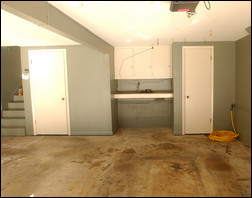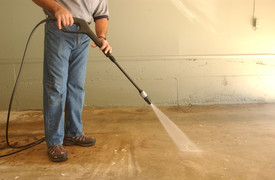Pressure washers are wonderfully tools that quickly handle tasks that would take hours of backache-inducing work if done by hand. It’s amazing what you can clean with a well-directed, pressurized stream of water. Here is what you need to know before you head to the store.
 Major mess: It would take hours to clean this garage floor by hand. Photo courtesy of Thompson’s Water Seal. |
Types of Pressure Washers
Pressure washers come in two basic categories based on how they’re powered: electric and gasoline. The electric units are more for home use, such as washing cars, boats and patio furniture, and generally generate 1,000 to 2,000 pounds per square inch (PSI) of pressure, although the high-end models can be quite powerful. They start at about $100 and require virtually no maintenance. Professional cleaners and painters use gas-powered units that generate 2,500 to 5,000 PSI of pressure. They’re ideal for big jobs, like scraping loose paint from the house before re-painting. They start at about $300—and can into the thousands—and need to be maintained like other lawn equipment.
Jeff Wilson, a regular host on HGTV and the DIY Network and a consultant for Thompson’s Water Seal, is sold on electric models for at-home use. “If you need a gasoline-powered one, you can rent one,” he says. “They’re dirty, they’re messy, they’re loud and they’re dangerous. If the thing will sit most of the time, it will age as it sits. Gas will get gummy, and you’ll have to winterize it. After five or six years, you’ll put it at the curb.”
If you just have one job to do, such as pressure-washing your house before you paint it, consider renting. Plan on spending $50 to $70 a day.
 Cleaning power: A pressure washer is the perfect tool for removing the dirt and grease embedded in the concrete. Photo courtesy of Thompson’s Water Seal. |
Performance Factors
There are four basic elements to pressure washer performance: pressure, flow rate, temperature and tip size, says Justin Sucato, president of Carrara Companies, a cleaning, restoration and construction company based in Cuyahoga Falls, Ohio.
The most important of these elements are pressure and flow rate. Pressure dislodges dirt, grease, mold and other contaminants, and the water carries them away. Pressure is measured in pounds per square inch (PSI). Flow rate is measured in gallons per minute (GPM). The higher the pressure and the more gallons per minute that a unit produces, the more powerful it will be.
Temperature relates to hot-water or cold-water pressure washers. Virtually all pressure washers made for home use are cold-water, says Andrew Pierce, director of marketing for EveryPressureWasher.com, an online store that sells anything and everything to do with pressure washers. The benefit of a hot-water pressure washer, Sucato says, is that the hotter the temperature, the less cleaner that’s needed. For professionals (and homeowners, too), that saves money on cleaning supplies.
Tips, or nozzles, come in four sizes, Sucato says, and they are measured in degrees: zero, 15, 25 and 40. The zero, or red, tip is a blaster. It provides the most intense cleaning power and needs to be used very carefully to avoid injury and damaging the surface to be cleaned. Actually, it’s best saved for use by professionals, Sucato says.
The 15-degree, or yellow, tip is good for powerful cleaning, such as removing paint and grease. The 25-degree, or green, tip, is good for general cleaning of dirt, mold, mildew and algae. The 40-degree, or white, tip is a rinsing tip and also can be used for cleaning lightly soiled areas.
Less-expensive pressure washer models will come with one, adjustable tip, Pierce says. Higher-end ones will have a set of all four tips.
What You Can Clean
Pressure washers can dispatch a lot of grunge and grime, Wilson says. They’re wonderful for cleaning concrete and stone walkways and driveways, pavers, garage floors, siding, brick, masonry, wood decks, pool decks, cars, trucks, boats and patio furniture.
Wilson says he doesn’t recommend them for washing mold and moss off an asphalt shingle roof because of the risk of ripping the grit off the shingles. Since they put out a tremendous amount of water, they’re generally not intended for indoor use at home unless it’s a basement floor with a drain. And they’re never appropriate for cleaning anything that’s alive or growing, no matter how muddy your dog or your soccer player is.
The Right Size Washer for the Job
The biggest, baddest pressure washer isn’t necessarily the best one for the jobs you need to do. A unit that’s too powerful can do more damage than good. The
 Transformation: Here’s the end result after the floor was cleaned with a pressure washer and coated with Thompson’s Water Seal Garage Floor Epoxy Coating. Photo courtesy of Thompson’s Water Seal. |
general rule of thumb is to use the lowest pressure and the largest tip size that will get the job done to reduce the risk of damaging the surface that’s being cleaned.
For example, Thompson’s Water Seal’s certified contractor manual recommends using a PSI of 1,500 to 2,500 for cleaning decks made of hardwoods, such as pine. For softwoods, such as cedar, it recommends a PSI of 1,200 to 1,500 because they’re more easily damaged.
A unit that produces 1,000 to 2,000 PSI and generates two to three gallons of water per minute (GPM) is ideal for cleaning cars, light trucks, boats, gutters, windows, decks, patio furniture and brick, Sucato says. For major jobs, such as stripping paint from a house or removing heavy grease stains, he recommends a unit with 3,000 to 5,000 PSI and four to five gallons per minute. Unless you plan on using the washer enough to justify the expense, that’s probably a unit you would want to rent for the occasion.
Detergents
Power washers work great in conjunction with cleaners; many have a built-in cups to dispense them, Pierce says. If you’re going to run a cleaner through the pressure washer, he recommends sticking with products specifically manufactured for that use. Household dish soaps and cleansers can damage the pump. And never run bleach through the pressure washer, Sucato says, as it will eat up the seals.
 |
||||
|
||||
Pre-Wash Checklist
Make sure the water supply is hooked up before you turn on a pressure washer. “You’ll fry out your pump if you don’t,” Pierce says. Check the tips to make sure they’re not clogged, and secure the connections. Test the pressure on the lawn— “the grass can grow back,” Pierce says—to get a feel for the force. It’s better to test there than put a dent in your car or obliterate the top layer of wood on your decking. Pull back a bit on the sprayer wand if the force is too strong; move in closer for additional force. For recommendations on nozzle distance for cleaning patio furniture to concrete, check out EveryPressureWasher.com’s project guide.
If you are using chemicals to clean your siding and there’s a chance of them getting on the shrubs, spray them down first with a garden hose, Sucato says. Water them again after the job is finished to wash off any remaining chemicals.
Also, keep in mind that pressure washers use a lot of water. If your house has a well, it might have trouble keeping up with the amount of water the washer pulls, Sucato says. “People can pump water into a 55-gallon tank and use that as a backup,” he says.
And if you live in a part of the country that has restrictions on outdoor watering, check with your municipality before starting your project. There’s nothing like a hefty fine to spoil the satisfaction of a squeaky clean driveway.
Maintenance
Maintenance on a gas-powered pressure washer is “very similar to a lawn mower,” Sucato says. Service it once a year; change the oil and check the filters. Electric pressure washers are virtually maintenance-free. The one thing you need to do with both kinds of units is make sure it’s completely drained after each use, he says, especially if you get freezing temperatures during the winter—otherwise, the water will freeze, expand and damage the unit.
Check the pump seals periodically, but they probably won’t need changing more than once every five to 10 years. Also, there are washers in the hose and tip connections that will sometimes pop out. It’s a good idea to keep a couple of extras on hand. Store them out of the weather.
For an easy-to-follow video and step-by-step written instructions, check out Renovate Your World’s “How To Pressure Wash.”
Credit: Renovate Your World




























